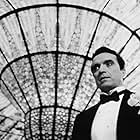Les Couleurs du diable
Titre original : Les couleurs du diable
NOTE IMDb
5,1/10
51
MA NOTE
Ajouter une intrigue dans votre langueA young talented painter dreams of glory. A man promises it in exchange for his talent and his soul.A young talented painter dreams of glory. A man promises it in exchange for his talent and his soul.A young talented painter dreams of glory. A man promises it in exchange for his talent and his soul.
Photos
Histoire
Commentaire à la une
This movie is a modern version of the Faust legend, with the hero, Nicolas, a young painter who accepts the help of a mysterious stranger, Bellisle, who promises to provide him with the inspiration that will turn him into a success. This consists of bringing the painter into contact with real-life experiences of death in various forms, and it works - Nicolas's morbid paintings of violent death attract a following and soon he is a commercial success. But it soon becomes clear that Bellisle is not merely maneuvering Nicolas into a position where he can witness tragedies that were bound to happen anyway; he is in some way setting up the situations that his protegé will use for inspiration, and eventually Nicolas himself becomes drawn into the crimes as a protagonist. It's not perfectly clear who Bellisle actually is; another painter, also one of Bellisle's clients, tells Nicolas that he doesn't really exist. Is he the devil, or is he somehow Nicolas's ambition, embodied as an amoral, conscienceless force, using and using up everyone around him as fuel for his insatiable appetite for fame and success? Wadeck Stanczak is not terribly convincing as the tempted painter, Nicolas. An actor like Anton Walbrook would have been great in such a role. Stanczak has the bohemian look down alright, though his long hair is annoyingly neat throughout (a REAL painter would look scruffier, especially after being up all night watching murders and suicides). But his acting range is limited; he really has only 2 speeds - pouty tantrums when he wants to show us the "artistic temperament", and a wide-eyed Candide gaze, when he wants us to remember that he's really not a bad guy, he's just fallen in with a rotten crowd. I never feel his genuine corruption, which takes all the tension out of his struggle with Bellisle. Joseé Quaglio, who plays an older painter who has already succumbed to Bellisle's bargain, is much more convincing at showing the moral ruin and despair that accompany such corruption. The main reason for watching this film is to see Ruggero Raimondi, who is fast becoming my favorite European actor. What a pity he's wasted his life singing opera, when he could have become one of the great charismatic screen villains! He's a perfect Mephistopheles in this movie, with those piercing dark eyes and arrogant smile; it doesn't hurt that he's either very tall or Stanczak is quite short - in any case, he looms over his victim like an amiable executioner. His voice is rich and expressive; I watched closely at the beginning because his French is so fluent I thought that perhaps he was being dubbed by a native French-speaker, but in fact that is his voice. I noticed a charming Italian accent from time to time, when he spoke forcefully - like all truly great villains, Bellisle never has to raise his voice. Poor Nicolas doesn't really stand much of a chance against such an antagonist; Bellisle really needed a more passionate character to be a believable opponent.
Meilleurs choix
Connectez-vous pour évaluer et suivre la liste de favoris afin de recevoir des recommandations personnalisées
Détails
- Durée1 heure 30 minutes
- Couleur
- Mixage
- Rapport de forme
- 1.66 : 1
Contribuer à cette page
Suggérer une modification ou ajouter du contenu manquant

Lacune principale
By what name was Les Couleurs du diable (1997) officially released in Canada in English?
Répondre





















